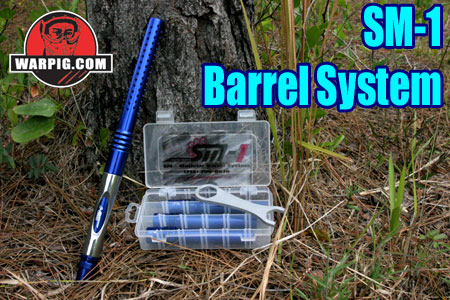  |
|
|
|
|
|
|
  |
|
|
|
|
|
|

What
do you think?
|

SM1 Barrel System By Bill Mills April 2004
In 1998 Luis Sanchez founded Sanchez Machine. Having worked in the paintball barrel manufacturing industry, Sanchez wanted to strike out on his own, and produce his own line of barrels. In the process, Sanchez Machine ended up producing barrels as a contractor for some well known brand names, and eventually released the SM-1 barrel which caught the attention of many in the paintball industry when shown at the 2003 PSP Los Angeles Open. Because Sanchez Machine is a custom shop they can produce barrels to order, but the SM-1 comes in some “ready to roll” configurations. With the idea that bore match is important to both velocity consistenency and accuracy, the SM-1 features interchangeable aluminum breech and rear sections that fit into a reinforcing stainless steel sleeve. Cut outs in the sleeve make it easy to identify the SM1 logo and the bore size marking on the insert section. Because the breech is a part of the insert, each set must be for a particular paintgun thread type.
The inserts and tips are assembled into a barrel by screwing them into the stainless steel sleeve. Fine, reversed threads are used to connect the pieces. This means that if a barrel becomes tight in a paintgun, twisting it counter clockwise will unscrew the barrel from the paintgun, not disassemble the barrel.
The standard SM-1 kit includes a full fourteen inch barrel with .689 inch insert, a wrench, and a set of inserts in .679, 683 and .688 diameters, and a wrench.
Using the insert matched to the paint, the barrel performed well, and was reasonably quiet. One item of note was that the reverse threaded assembly system prevents the barrel from unscrewing when being taken out of a paintgun, but care must be taken when screwing the barrel into a paintgun, not to twist too far, or that will begin taking the barrel apart. All of the inserts feature o-rings on the breech side which help them lock snugly to the paintgun, as well as o-rings to lock them into the stainless steel sleeve. An o-ring on the front of the sleeve similarly provides friction to hold the tip securely in place. There were no problems with the barrel working loose during testing.
The first tests compared the velocity of two 10 shot strings fired from the stock CCM barrel as a baseline for comparison, and the 14 inch SM-1 barrel with .679, .683, .689, and .696 diameter inserts. With a total of 20 shots through each configuration, enough data would be collected to compute standard deviation data for each paint to barrel match. The velocity settings of the J2 were not adjusted when the barrels were changed, so that differences in gas efficiency caused by paint to barrel fit would also be noticeable in the data produced.
Surprisingly, the best velocity consistency did not come from the insert that fit the paint the best by the blow test method. Consistency wise, the smallest bore insert, the .679 performed the best. The .679 and .683 inserts were close to each other with a standard deviation value of 2.8 and 3 respectively. The .689 insert yielded a standard deviation of 5.6, while the largest insert came in at 5.2. The two tight bore inserts, had a close average velocity at 300.8 and 300, while average velocity dropped over to 292.2 and 270.2 for the matching and oversized insert, indicating a steady drop in gas efficiency as the barrel diameter increases. For complete velocity comparison data, click here. Target testing was performed with the insert that best matched the paint by the blow test (.689) and the insert that produced the smallest standard deviation over the chronograph (.679.) Each of these was tested with a string of 10 shots fired at a rate of one shot per second, with both the long and short barrel tips. They were fired at paper test targets at a range of 75 feet. For each barrel set-up, velocity was adjusted prior to the 10 shot string, and aim and target positioning were adjusted so that the group of shots would fall within the target frame. For comparison, photographs of the paper targets were corrected for distortion caused by camera position, impact points recorded and then overlaid to give a visual representation of the shot groupings.
The SM-1 barrel system is available factory direct from Sanchez Machine via their web site, or through paintball dealers. The author would like
to thank Patrick Stemphley for his assistance in product testing at Hurricane
Paintball Park.
|
| Copyright © 1992-2019
Corinthian Media Services. WARPIG's webmasters can be reached through our feedback form. All articles and images are copyrighted and may not be redistributed without the written permission of their original creators and Corinthian Media Services. The WARPIG paintball page is a collection of information and pointers to sources from around the internet and other locations. As such, Corinthian Media Services makes no claims to the trustworthiness or reliability of said information. The information contained in, and referenced by WARPIG, should not be used as a substitute for safety information from trained professionals in the paintball industry. |